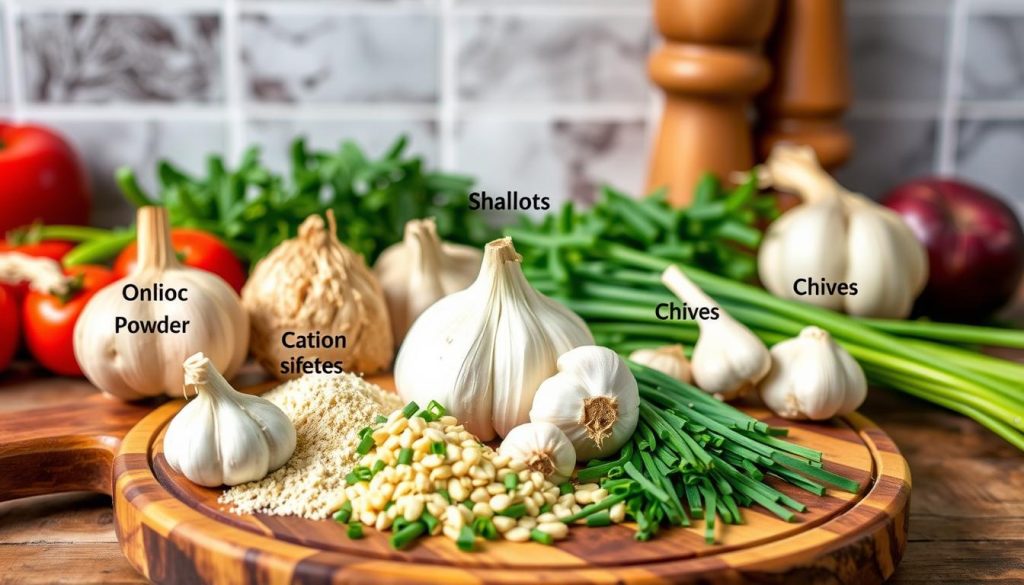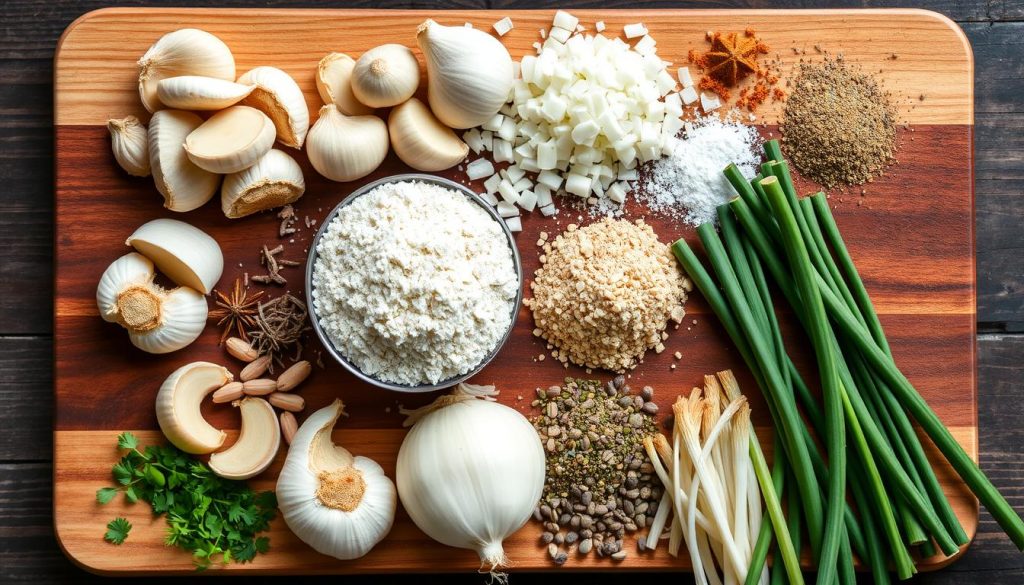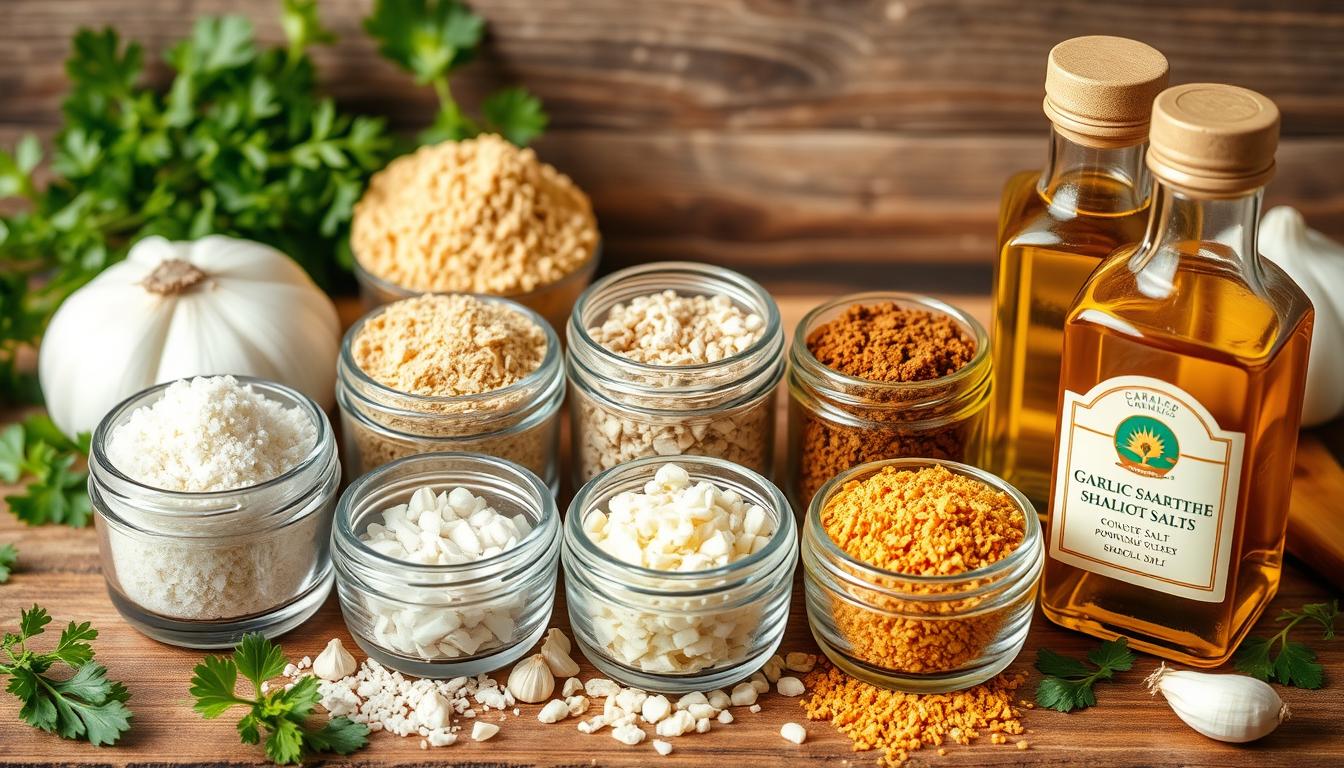Granulated garlic is a key seasoning that makes many dishes taste better. Sometimes, you might need a substitute for it. This guide will show you the best options to keep your food delicious.
Choosing garlic substitutes is easy once you know your options. Whether you’re following a recipe or trying something new, knowing how to replace granulated garlic is important. We’ll look at the best substitutes, their flavors, and tips to improve your cooking.
Understanding Granulated Garlic
Granulated garlic is a special ingredient in cooking, adding flavor and versatility. Knowing what granulated garlic is helps you see its value in many recipes. It’s made by drying garlic cloves and grinding them into coarse granules. This keeps a strong garlic taste that boosts many dishes.
What is Granulated Garlic?
Granulated garlic looks like garlic powder but has bigger pieces, like cornmeal or sand. Its texture makes it blend well in liquid dishes. Unlike garlic powder, which packs a stronger flavor, granulated garlic has its own strengths. You might need more of it to get the same taste.
Common Uses for Granulated Garlic
Granulated garlic is great for many cooking tasks. It’s perfect for:
- Soups and stews
- Marinades and dressings
- Dry rubs for meats
- Seasoning for vegetables
It works well in both dry and wet mixes, making it a favorite in kitchens. Using granulated garlic makes cooking easier without losing flavor. It’s great for both home cooks and professional chefs.
Why Use Substitutes for Granulated Garlic?
In the world of cooking, knowing when to swap out granulated garlic can make a big difference. It’s useful when you’re out of granulated garlic or need to fit dietary needs. Using substitutes lets you keep cooking and try new tastes.
Benefits of Substituting
Choosing garlic substitutes offers more than just a replacement. They add special flavors and smells to your food. For instance, garlic powder is great for quick meals because it tastes strong right away. Dried garlic lasts longer than fresh, making it perfect for daily cooking.
Situations Where You Might Need a Substitute
There are times when you might need a garlic substitute:
- If you run out of granulated garlic while preparing a meal.
- When accommodating a garlic allergy within your household.
- If you wish to make a dish that calls for fresh garlic but only have dried options available.
These situations show why knowing how to swap out granulated garlic is key. Each substitute has its own special traits. This lets you keep your dish’s essence while exploring new tastes.

Granulated Garlic Substitutes: Your Quick Guide
Using substitutes for granulated garlic can make your dishes taste better and add variety. It’s important to know the different garlic substitutes. Each one has its own flavor and texture, so picking the right one is key.
Different Types of Substitutes
There are many garlic substitutes to choose from:
- Garlic Powder: The richest form of garlic, offering a concentrated flavor.
- Fresh Garlic: Provides a unique texture and a milder taste great for many recipes.
- Onion Powder: Excellent for enhancing savory dishes, it can replace garlic in various applications.
- Shallot Powder: A milder alternative that brings a sweet onion flavor.
- Garlic Salt: Combines garlic powder with salt, ideal for seasoning without needing additional salt.
- Garlic Flakes: Offer a coarser texture similar to granulated garlic, but with distinct consistency.
- Garlic Paste: A fresh option that gives off a more robust flavor timbre.
How to Choose the Right Substitute
Choosing the right substitute depends on your dish and the flavor you want. For a milder taste, try fresh garlic or shallot powder. For a strong flavor, garlic powder or garlic salt is better. Remember, the texture of granulated garlic is different from garlic powder, so it might change your dish.
Using the right amount is important. For example, use ¾ teaspoon of garlic salt for one clove of fresh garlic. Knowing about garlic substitutes helps keep your cooking tasty and fun.

Top Substitutes for Granulated Garlic
Looking for good substitutes for granulated garlic can make your dishes better. These options keep the garlic flavor in your cooking.
Garlic Powder
Garlic powder is finer and stronger than granulated garlic. Use half a teaspoon of garlic powder for every teaspoon of granulated garlic. It’s great for adding flavor without too much.
Fresh Garlic
Fresh garlic adds a strong and sweet taste to food. One clove of fresh garlic is like one teaspoon of granulated garlic. It’s healthy and adds lots of flavor.
Onion Powder
Onion powder is a good choice if you want something milder. It’s similar in texture to granulated garlic and can be used in the same amount. It’s a favorite in many kitchens.
Shallot Powder
Shallot powder adds a nutty flavor to dishes. Use it in the same amount as granulated garlic for a smooth taste. It’s a great way to change up your flavors.
Garlic Salt
Garlic salt is saltier than granulated garlic because it has garlic powder and salt. Use less of it to avoid too much salt. It’s convenient and flavorful, but watch the salt levels.
Garlic Flakes
Garlic flakes are larger than granulated garlic and need less. They take time to hydrate, so they’re different from other options. Use them carefully in liquid-based recipes.
Garlic Paste
Garlic paste is very flavorful and concentrated. Use half the amount of granulated garlic to avoid overpowering your dish. It adds a rich taste and aroma.
Conversions: How Much to Use?
Knowing the right amounts is key when swapping out granulated garlic. Getting it wrong can make your dish too strong or too weak. Here are some garlic conversion tips to help you adjust flavors well. Learning these ratios keeps your dishes tasting great.
Garlic Conversion Measurements
Here’s a quick guide for common garlic swaps:
| Garlic Type | Conversion Ratio |
|---|---|
| Granulated Garlic | 1 teaspoon = 1 clove of garlic |
| Garlic Powder | 1/8 teaspoon = 1 clove of garlic |
| Minced Garlic | 1/2 teaspoon = 1 clove of garlic |
| Freshly Chopped Garlic | 1 teaspoon = 1 clove of garlic |
| Garlic Salt | Adjust salt levels according to taste |
Adjusting Recipes with Substitutes
When swapping out ingredients, think about how it changes the flavor. For example, garlic salt needs less salt in your recipe. This keeps the taste balanced. You might also need to adjust other spices or herbs for the best flavor.
Remember, changing ingredients can affect how your dish turns out. You might need to try a few times to get it just right.
Tips for Using Garlic Substitutes Effectively
Using garlic substitutes in your cooking requires knowing about flavor and cooking times. Each substitute has its own taste, which can change your dish a lot. For example, fresh garlic tastes stronger and cooks faster than granulated garlic. You might need to adjust how long you cook it.
Flavor Profiles and Cooking Times
Choosing the right garlic substitute is key to keeping your dish’s flavor. Here are some tips:
- Fresh garlic: It has a strong taste; cook it quickly.
- Granulated garlic: It’s milder; use it in longer cooking times.
- Asafoetida (hing): A little goes a long way; start with a small amount and adjust.
- Shallots: Great for adding a sweet hint, like onions.
- Garlic oil: Use 1 tablespoon for each clove for a subtle flavor.
Balancing Other Ingredients in Your Recipe
It’s important to balance flavors in your cooking. When using garlic substitutes, think about how they mix with other ingredients. For instance, using garlic salt instead of fresh garlic means you should use less salt. Try these:
- Garlic powder (1/8 teaspoon per clove) for a light touch.
- Garlic flakes (1/2 teaspoon for each clove) to keep texture.
- Minced garlic from a jar (1/2 teaspoon equals one clove) for easy use without losing flavor.
By following these tips, you can make tasty meals and balance flavors well.
Conclusion
Learning about garlic substitutes can really boost your cooking skills. This guide has shown you many options, from dry spices to fresh ones. Each one adds its own special taste, helping you keep garlic flavor in your dishes, even without granulated garlic.
When trying out garlic substitutes, remember the right amounts to use. For example, use a 1:1 ratio for garlic powder. But, garlic salt needs a 1:2 ratio because it has more salt. Your personal taste matters a lot in getting the flavor just right in your recipes.
This guide is here to help you use different garlic substitutes well. Whether you pick garlic flakes or minced garlic, you can cook with confidence. You’ll never worry about not having garlic again. Enjoy the rich flavors garlic substitutes add to your food!
Source Links
- https://www.thekitchn.com/garlic-substitutes-23003975
- https://discover.texasrealfood.com/swap-and-savor/how-to-substitute-granulated-garlic-for-garlic-powder
- https://www.realsimple.com/granulated-garlic-vs-garlic-powder-8717867
- https://www.webstaurantstore.com/blog/3642/garlic-compared.html?srsltid=AfmBOopn3AeofOx3E9NcnNYsZXP7XabhWsL353vYuAKo8efqBUnCEPCA
- https://shop.ofi.com/granulated-garlic-vs-garlic-powder
- https://www.allrecipes.com/granulated-garlic-vs-garlic-powder-7500066
- https://www.lowcarb-nocarb.com/granulated-garlic-recipe/
- https://www.bhg.com/recipes/how-to/cooking-basics/garlic-substitute/
- https://julieblanner.com/garlic-conversion-guide/
- https://www.cozymeal.com/magazine/garlic-powder-substitutes
- https://www.omnicalculator.com/food/garlic-converter
- https://www.forksoverknives.com/how-tos/fresh-to-dried-herb-conversion-guide-plus-garlic-onion-powder/
- https://www.allrecipes.com/garlic-substitute-7974706
- https://www.thekitchn.com/garlic-substitutes-chart-best-substitutes-for-fresh-garlic-23116530
- https://www.webstaurantstore.com/blog/3642/garlic-compared.html?srsltid=AfmBOoqoyAZbILE2DrL1v69rk275h6UjfiofnB37X_eCV8y6logUsHD2
- https://meghanitup.com/substitute-for-garlic-powder/
- https://www.ispiceyou.com/blogs/news/garlic-granulated-vs-garlic-powder?srsltid=AfmBOooZ00t0k6VEba21U9VaRYpWAnSKoAQHDCnQ6t313jTC9WanRbgb
- https://www.ispiceyou.com/blogs/news/garlic-granulated-vs-garlic-minced?srsltid=AfmBOopV6eiX3f5AtlW4K5t2tsW21K4fiSEC87CGSibzUiDeSrenWTBB
